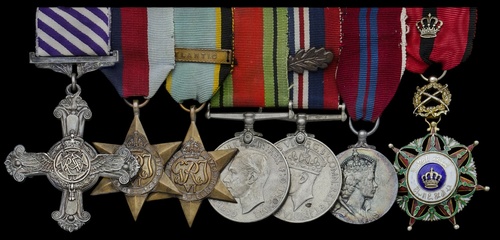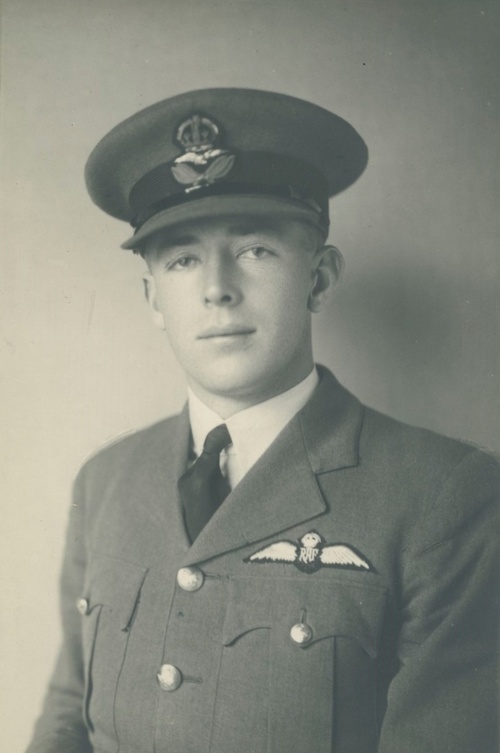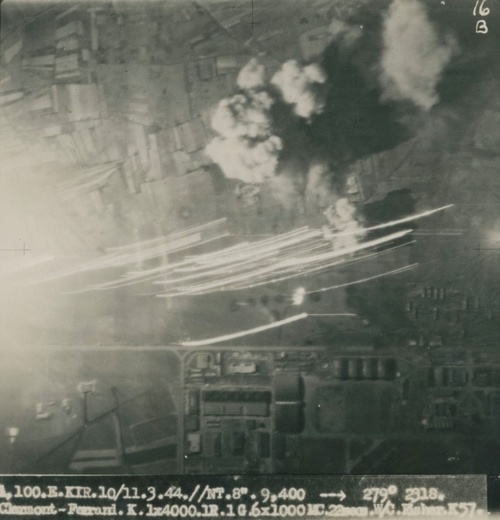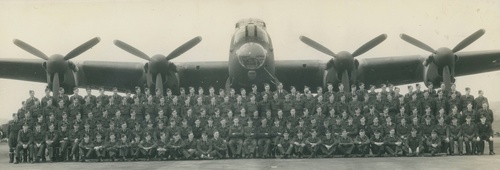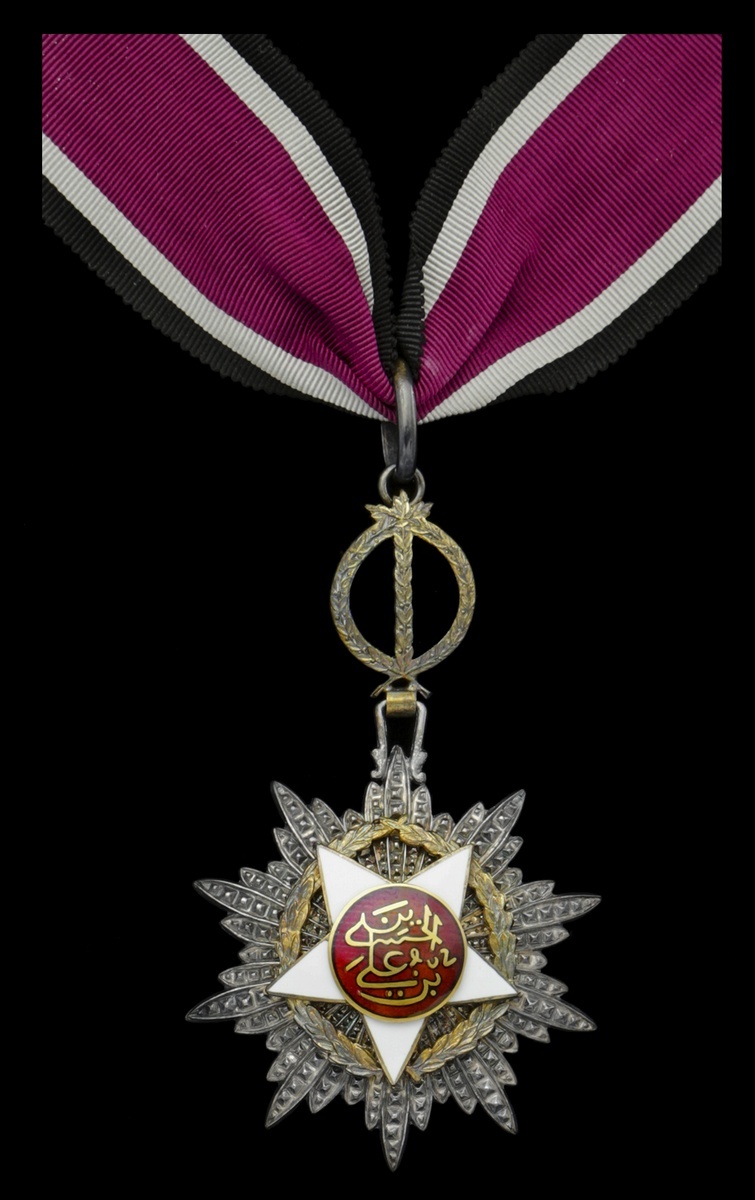Auction: 19002 - Orders, Decorations and Medals
Lot: 406
An outstanding Second World War D.F.C. group of eight awarded to Wing Commander H. W. H. 'Bill' Fisher, Royal Air Force
Born near Perth, Western Australia, Fisher gained a pre-war commission in the R.A.F. on the back of friendly assistance from Group Captain Frank McNamara, V.C., the latter believing his young charge 'would achieve'
McNamara was not to be disappointed for, 'undeterred by the heaviest of anti-aircraft fire or the most intense searchlight activity', Fisher gained a fearsome reputation for making numerous - hair-raising - dummy runs over his targets in order to meet the highest standards of accuracy, the whole in outdated Hampdens
As a result, his aircraft was badly shot-up on a number of occasions, a case in point being an attack on the Scharnhorst, Gneisenau and Prinz Eugen at Brest in June 1941: in the face of heavy flak, he remained over the target area for 25 minutes and carried out two dummy runs before finally attacking. He had earlier deployed similar tactics over Berlin and, when ordered to attack an aerodrome in France in poor weather in December 1940, dropped to 2,000 feet and carried out five dummy runs
His piloting skills were again in evidence on a gardening trip to Bordeaux in March 1941 when, having dropped a well-placed 'Forget-Me-Not' in the harbour, his Hampden was engaged by an enemy night fighter. His skilful manoeuvring and pilot-to-gunner communication resulted in the enemy fighter's demise
Awarded the D.F.C. for this gallant first tour of operations in No. 49 Squadron, Fisher wrote an 'Operational Handbook' for No. 5 Group and returned to the fray with command of No. 57 Squadron in the period August 1943 to April 1944
Post-war, he was appointed C.O. of the Arab Legion Air Force in Jordan, in which capacity he was charged with flying home the body of King Abdullah, following his assassination in Jerusalem in July 1951
Distinguished Flying Cross, G.VI.R., the reverse officially dated 1941; 1939-45 Star; Air Crew Europe Star, clasp, Atlantic; Defence and War Medals 1939-45, M.I.D. oak leaf; Coronation 1953; Jordan, Hashemite Kingdom, Order of Istiqlal, Commander's neck badge, by Goldsmiths & Silversmiths Co. Ltd., London, silver-gilt, silver and enamel, hallmarks for London, 1949, in its case of issue; Iraq, Kingdom, Order of El Rafidain, Military Division, 5th Class breast badge, silver-gilt and enamel, with original wearing pin, together with the recipient's wartime identity discs, mounted as worn where appropriate, good very fine (8)
D.F.C. London Gazette November 1941. The original recommendation states:
'Flight Lieutenant Fisher has completed 185 hours' operational flying, involving 27 sorties. During the course of these operations a wide variety of targets have been attacked, including Berlin three times, Bremen four times, Brest four times, Magdeburg and many others. Flight Lieutenant Fisher has also successfully carried out a number of special mining operations.
This officer, who is an Australian, has always set an outstanding example of courage and determination in the face of the enemy. Flight Lieutenant Fisher is undeterred by the heaviest anti-aircraft fire or the most intense searchlight activity. On the night of 17-18 March 1941, he was detailed to attack an objective in Bremen. In spite of the intense searchlight activity and accurate light and heavy flak, the attack was made from 8,000 feet. On the return journey the Navigator was taken ill and was unable to navigate, but the aircraft was brought safely back to its base.
On the night of 9-10 April 1941 - and again on the night of 17-18 April - Flight Lieutenant Fisher attacked Berlin. On both occasions attacks were made from 11,000 feet after dummy runs had been made. On the second occasion Flight Lieutenant Fisher's aircraft was badly damaged by intense anti-aircraft fire, hits being sustained in the tanks, tail boom and W./T. equipment; in spite of this damage the target was accurately bombed with a 2,000 lb. bomb.
Many of Flight Lieutenant Fisher's operational flights were made during the winter months, in very bad weather conditions, and he was on several occasions one of the few to find the target. For instance, on the night of 7-8 December 1940, he was detailed to attack the aerodrome at Vannes and his was the only aircraft from the Squadron which attacked the objective owing to unfavourable weather conditions. Eight 250 lb. bombs were dropped on the hangars and buildings from 2,000 feet, after four dummy runs had been made. The aircraft was brought safely back to its based in spite of the most severe icing conditions and static, which rendered the wireless useless.
On the night of 21-22 March 1941, Flight Lieutenant Fisher was returning from a mining operation when he was attacked by an enemy night fighter. His skilful handling of the situation not only enabled him to extricate his aircraft undamaged but also enables his gunners to destroy the enemy aircraft, its destruction subsequently being confirmed. On several other occasions he has been attacked by enemy night fighters but has always escaped undamaged.
On night 10-11 June 1941, Flight Lieutenant Fisher was detailed to attack Brest. Although intense anti-aircraft fire and searchlight activity were encountered - the aircraft being hit several times - two dummy runs were made and he remained in the target area for 25 minutes. On many occasions this Officer has spent considerable periods in the target area in order to ensure positive identification, and he has frequently made a number of dummy runs over heavily defended targets in order to ensure accuracy of aim.
Flight Lieutenant Fisher, who is a Deputy Flight Commander, has always set a most outstanding and invaluable example of leadership and devotion to duty.'
Hurtle William Hamilton Fisher was born at Peppermint Grove, near Perth, Western Australia on 19 March 1917. Having attended Woodbridge Prep School as a boarder, and Guildford Grammar, he commenced an engineering course at the School of Mines in Kalgoorlie.
In November 1938, however, he decided to apply for a commission in the Royal Air Force, an ambition much assisted by Group Captain McNamara, V.C., the Air Liaison Officer at Australia House in London. Duly selected, Fisher commenced his Elementary Flying Course and was still in training at the outbreak of hostilities in September 1939. 'Wings' up, his first posting was to No. 185 Squadron at R.A.F. Cottesmore, where he also attended a conversion course for Hampdens. In April 1940, whilst on assignment to an O.T.U., he flew the highly unreliable Hereford aircraft. On one occasion, at 500 feet, one of the aircraft's engine seized and part of the rudder fell off: he made a forced-landing and damaged two parked aircraft before coming to a standstill.
No. 49 Squadron - First Tour - D.F.C.
In November 1940, Fisher joined No. 49 Squadron as a recently promoted Flying Officer. The Squadron - a Hampden unit - was based at Scampton and he flew his first sortie, against Cologne, on the last day of the month.
What followed typified the high calibre of Australian aircrew actively employed in Bomber Command, in Bill Fisher's case by a reputation for many 'dummy runs' over his targets in order to achieve first rate bombing accuracy. However heavy the opposition encountered - from flak, night fighters and searchlights - he displayed an unnerving capacity to keep his eye on the task in hand. No better summary of that determination and coolness may be quoted than the above cited recommendation for his D.F.C., written in September 1941, a recommendation peppered with high drama and flak damaged aircraft.
Taking a Hampden - the 'flying glass house' - over such heavily defended targets as Brest is one thing. Making two dummy runs and staying over such a target for 25 minutes - although piloting a heavily damaged aircraft - almost defies belief. Fisher's second outing to Berlin in April 1941 was no different and both sorties reflect an extraordinary degree of grim determination and heroism. And one cannot escape the fact he likely displayed similar traits elsewhere - perhaps during one of his four strikes against Bremen and certainly in making no less than five runs over Vannes airfield in shocking weather in December 1940.
He was awarded a well-deserved D.F.C. and, tour-expired, was posted to H.Q., No. 5 Group as a Squadron Leader in the Air Operations Branch. It was in this capacity that he wrote a much-valued Operational Handbook. He was mentioned in despatches (London Gazette 1 January 1943, refers) and met Robert Menzies, the Prime Minister of Australia.
No. 57 Squadron - C.O. and Second Tour
In August 1943, in the rank of Wing Commander, Fisher took command of No. 57 Squadron, a Lancaster unit operating out of Scampton but which later moved to East Kirkby. And between then and his transfer to a senior instructor's course in April 1944, he displayed all the hallmarks of his earlier tour of operations.
Berlin, Frankfurt, Leipzig, Schweinfurt, Stettin and Stuttgart were among his subsequent targets, in addition to some trips to France in the lead-up to the Normandy landings.
On one occasion, after returning to base at dawn from a sortie, he followed normal procedure by opening his Lancaster's bomb bay as he taxied to dispersal. The peace of the cockpit was suddenly shattered by the yells of his Rear Gunner to speed up: two hung-up bombs had dropped onto the dispersal track.
An appointment as Station C.O. of R.A.F. Fraserburgh having ensued, Fisher ended the war with an appointment at Cranwell.
Post-war - C.O. of the Arab Legion Air Force - assassination of King Abdullah
In December 1945, he was appointed Inspector of the Royal Iraqi Air Force at Baghdad, in which capacity he travelled extensively before returning to an appointment at the Air Ministry in London in June 1948. He was appointed to the Order of El Rafidain.
Two years later, Fisher assumed command of the Arab Legion Air Force under Glubb Pasha, his role being to build-up the fledgling force and assist in observation and transport operations. He also served as personal pilot to King Abdullah and King Tallal, in addition to taking Prince Hussein through his ab initio flying instruction.
Undoubtedly the most dramatic episode of his Jordanian command occurred in July 1951, when he flew King Abdullah to Jerusalem to attend an important religious event. The day after their arrival - on the 21st - Abdullah was assassinated at a mosque and Fisher was charged with flying home the king's body to Amman. It arrived at the airport with a motor escort, with wailing sirens, and was hastily taken aboard the aircraft on a stretcher, into the cabin. Once airborne, Fisher alerted the Jordanian officials and, three days later, at the king's state funeral, he organised a flypast. He was appointed a Commander of the Order of Independence.
Back in the U.K., Fisher's final appointment was in Fighter Command and he retired - at his own request - in early 1956. He had entered the jet age - in Meteors VIIIs at Church Fenton - in the interim.
Bill Fisher subsequently pursued a career in the aerospace industry, travelling to many parts of the world. He finally settled in Surrey, with his wife Joan, whom he had married in 1940.
Sold with an archive of original documentation and photographs, including:
(i)
The recipient's R.A.F. Pilot's Flying Log Books (Form 414) (2), covering the periods February 1939 to July 1941 and August 1941 to October 1955, the second with two or three inserted 'target photographs'.
(ii)
Letter from Group Captain Frank McNamara, V.C., dated at Australia House, London on 6 February 1939, wishing the recipient a happy and successful career in the R.A.F. ('I feel sure you will achieve … ').
(iii)
The recipient's commission warrant for the rank of Acting Pilot Officer, dated 28 April 1939.
(iv)
A congratulatory letter from the C.O. of No. 5 Group regarding the recipient's award of the D.F.C., dated 23 November 1941.
(v)
The recipient's mention in despatches certificate in the name of 'A./Squadron Leader H. W. H. Fisher, D.F.C., Royal Air Force', dated 1 January 1943, together with a related congratulatory letter from H.Q., No. 5 Group.
(vi)
A wartime watercolour depicting a Hampden of No. 49 Squadron, signed by Nigel Bruce', and two pencil portraits of the recipient in uniform, dated '1942' and signed by 'Ursula Mason.
(vii)
A small quantity of wartime photographs, including a target image taken over Clermont-Ferrand on the night of 10-11 March 1944 and a group photograph of No. 57 Squadron, the recipient seated centre as Squadron C.O.
(viii)
Buckingham Palace certificate for the Coronation Medal 1953, in the name of 'Wing Commander H. W. H. Fisher, D.F.C.'
(ix)
Permission to wear warrant for the recipient's Hashemite Kingdom Order of Istiqlal, 3rd Class, 'in recognition of valuable services rendered by you while seconded to the Arab legion Air Force', dated 23 May 1953, together with related Foreign Office forwarding letter.
(x)
A quantity of letters and reports relating to his periods of service in Iraq and Jordan in the post-war era and a quantity of career newspaper cuttings.
(xi)
Official correspondence regarding the recipient's application to be placed on the Retired List in 1955; and a typed career summary, 4pp.
Subject to 20% VAT on Buyer’s Premium. For more information please view Terms and Conditions for Buyers.
Sold for
£3,200
Starting price
£2500

